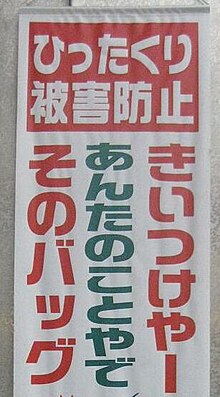
Back Basa Japang Kansai BJN Dialecte kansai Catalan Kansai-Dialekt German Dialecto de Kansai Spanish Kansain murre Finnish Kansai-ben French Dialecto de Kansai Galician Kanszai dialektus Hungarian Dialek Kansai ID 近畿方言 Japanese
This article includes a list of general references, but it lacks sufficient corresponding inline citations. (March 2008) |
| Kansai Japanese | |
|---|---|
| 関西弁 | |
| Native to | Japan |
| Region | Kansai |
Japonic
| |
| Language codes | |
| ISO 639-3 | – |
| Glottolog | kink1238 |
 Kansai-dialect area | |



The Kansai dialect (関西弁, Kansai-ben, also known as Kansai-hōgen (関西方言)) is a group of Japanese dialects in the Kansai region (Kinki region) of Japan. In Japanese, Kansai-ben is the common name and it is called Kinki dialect (近畿方言, Kinki-hōgen) in technical terms. The dialects of Kyoto and Osaka are known as Kamigata dialect (上方言葉, Kamigata kotoba, or Kamigata-go (上方語)), and were particularly referred to as such in the Edo period. The Kansai dialect is typified by the speech of Osaka, the major city of Kansai, which is referred to specifically as Osaka-ben. It is characterized as being both more melodic and harsher by speakers of the standard language.[1]
- ^ Omusubi: Japan's Regional Diversity Archived 2006-12-14 at the Wayback Machine, retrieved January 23, 2007